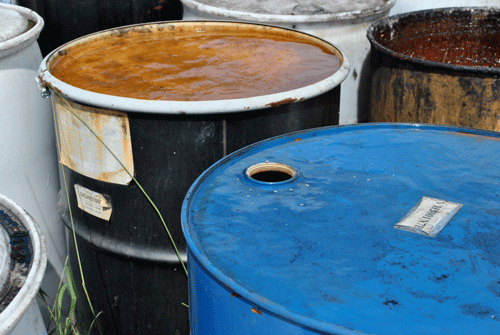

By Jami Davis
The production department continues to work on their biodiesel project in order to create fuel and educate students. Plans for this project have been in the works since 2006, and this upcoming school year the program has its own operational building.
In previous years the biodiesel fuel was created in the wood lab in the school building. This year, the school board approved the construction of a new building to house the project.
The program has received a $10,000 PEER Grant through John Tyler Community College, funding from Farm Bureau and other donations to help finance the building.
“We got a grant through John Tyler and we also won a $5,000 dollar grant from the state of Virginia. So basically those two things paid for the building. The county paid for the concrete and for some other features,” teacher Randy Bullock said.
The biodiesel project is a program that is uses green technology to convert waste into usable fuel. Biofuel is created from oils by a process called transesterfication.
“In [the process] the oil is reacted with an alcohol, typically methanol. The resulting chemical has significantly improved combustion properties over the original oil. This process produces glycerol as a by-product which is removed from the biofuel before it is used,” Chemistry teacher Dr. Kevin Moore said.
In comparison with the nearly $3.00 per gallon diesel fuel prices across Virginia, biodiesel can help to cut the amount of money spent on fuel for county vehicles.
“Per gallon if the oil is donated, which it always is, we can make the fuel for $1.00 a gallon. Also, we are hoping that by using solar panels to heat the oil we can lower the cost to 75 cents,” Bullock said.
A group of Bullock’s students came up with the idea to generate fuel from waste products created in the cafeterias at county schools.
“Some students in 2006 had the idea to turn cooking oil into a fuel. One of my students had read something about it. For a couple months I would stay up until one or two in the morning researching it. I found a plan for a processor and we built it. It was definitely a learning process. We all learned together,” Bullock said.
The biodiesel project was operational on a much smaller scale prior to this year. Bullock hopes to dramatically increase the amount of fuel created now that there are fewer space constrictions and less safety hazards.
“We used to create it in the building, so we used to make 30 gallons every other day. Now our capacity could increase up to 150 gallons a day, easily. Our max output could be as much as 300 gallons a day if we could get enough raw materials,” Bullock said.
There is still more work to be done inside of the new building before it will be fully operational and safe for students.
“We still have to go through all the safety rules and equipment first. We also still have to build a few things which my construction and production students will both be doing,” Bullock said.
Even though the project is not completely up and running yet, students who will be involved realize the benefits their program will have.
“I think it goes along with the ‘going green’ technology now. It’s good for the environment because we can make our own gas and not use real diesel fuels,” senior Ver’Rell McDonald said.